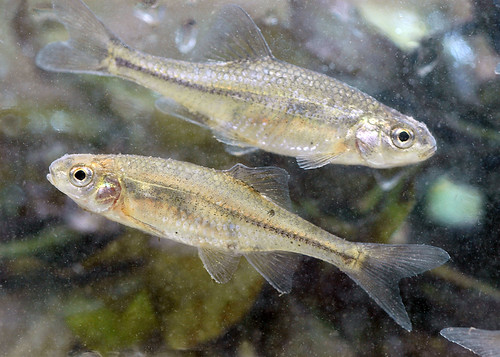
The Oregon Chub is making waves in history. This February, it became the first fish to be delisted from the Endangered Species List because of recovery (not extinction).
This success is directly attributable to more than 20 years of hard work by USDA’s Natural Resources Conservation Service (NRCS), the U.S. Fish and Wildlife Service (USFWS), the Oregon Department of Fish and Wildlife (ODFW), private landowners and other conservation partners.
While many people were involved in the recovery effort, the USFWS recognized 12 professionals who represent outstanding leadership in their respective agencies to recover the species. These individuals were honored during a “Recovery Champions” awards ceremony May 28 at the Finley National Wildlife Refuge in Corvallis, Oregon.
The Service chose Les Bachelor, district conservationist in Marion County, as the Recovery Champion for NRCS. He was instrumental in developing relationships with private landowners in Marion and Benton counties to restore Oregon Chub habitat on private lands.
“NRCS was critical to foster the relationships with private landowners to recover the species on private lands,” said Richard Hannan, deputy regional directory for the USFWS Pacific region during the awards ceremony. “Private landowners are key. NRCS has always been welcomed on private land because they have robust partnerships and relationships with those landowners. They understand that for conservation to be successful, it must begin on private lands.”
Most of NRCS’ work for Oregon Chub habitat was achieved through the Wetlands Reserve Program (WRP)—a Farm Bill program that helps landowners restore, protect and enhance wetlands to benefit migratory birds and other plants and wildlife, including endangered species. Bachelor spearheaded the program in Oregon’s Willamette Valley—an area historically known for its Oregon Chub populations.
The Oregon Chub is native to the Willamette Valley. When it was listed as endangered in 1993, there were only eight known populations. Now 22 years later, there are 80 known populations throughout the Willamette River basin and its tributaries, according to USFWS data. The recovery of the population is due largely in part to habitat improvement projects and introducing the Chub to new locations in its historical range.
Under the WRP, Bachelor and other NRCS staff worked with private landowners to secure seven conservation easements in the Willamette Valley. Five of those easements are in Marion County, and two are located in Benton County. Those easements cover 623 acres that provide long-term protection for Chub habitat.
NRCS funded 100 percent of the restoration work and land value for the permanent easements. The 30-year easements were performed under a cost-share between NRCS and the landowner.
“I feel honored to be part of the Oregon Chub interagency recovery team,” Bachelor said. “NRCS has given me the unique opportunity to work with private landowners to improve our natural resources. When I moved to the Willamette Valley in 1999, I started building my connections with private landowners and building a strong partnership with USFWS and ODFW. Our wetland restoration projects on private lands throughout the Willamette Valley have been integral to the recovery of the Oregon Chub. I am grateful for the many NRCS employees and partners who have contributed to the recovery and delisting of this species.”
This effort builds on the historic success of voluntary conservation practices on private lands that benefit wildlife while supporting working lands. Recently, because of proactive steps by private landowners to restore and improve habitat, the Louisiana black bear was proposed for delisting, and listing was not required for the Bi-State sage-grouse or the Arctic grayling. Read more about NRCS’ efforts to restore and protect Oregon Chub habitat on the NRCS Oregon website.

